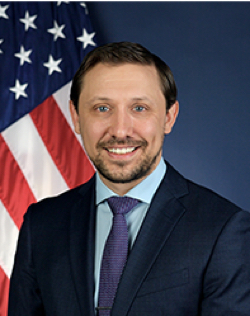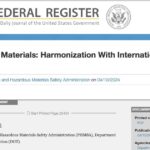In late August, the federal Pipeline and Hazardous Materials Safety Administration held a grants conference in Tysons Corner, Va. There, Deputy Administrator Tristan Brown talked about what hazmat teams can expect in terms of future grant allocations and what his office is doing to improve grant reporting.
In short, more money will be available due to the massive infrastructure bill recently passed. And, the agency is planning to extend filing deadlines as well as streamline the reporting process for those who are awarded grants. Of special interest to hazmat teams is the Hazardous Materials Emergency Preparedness grant.
Also Read: How to Prep for Upcoming Grants
Here’s a transcript of Brown’s remarks at the conference.

US DOT Deputy Administrator
Pipeline and Hazardous Materials Safety Administration
Thank you Aaron. And let me begin by thanking Andre White, Bonita Brown, Matthew Hufford, Carla Sheppard, Flor Valencia, Lisa Reichenbacher, Suzette Edwards, and all of the other PHMSA team members who’ve worked so hard to put on this conference but also to make the HMEP grant program what it is today — a critical pillar that supports our first responder community across the nation. I am grateful for the opportunity to speak to you this morning regarding the important actions the Pipeline and Hazardous Materials Safety Administration is taking to advance our mission to protect people and the environment by advancing the safe transportation of energy and other hazardous materials that are essential to our daily lives.
If there’s one takeaway I hope you leave with today, it is that we at PHMSA want to hear how things are working and we want to work with you to ensure we have a program that meets the intended goal of the program—to support you and to bolster your efforts to train and support or hazmat first responder community.
PHMSA’s goal for the agency’s Hazardous Materials Safety program is to reduce the risks inherent to the commercial transportation of hazardous materials by all modes.
We have two mandates for the Hazmat Program: Keep hazmat in the package and make sure emergency responders are prepared and trained to protect communities if or when a hazmat incident occurs.
These are accomplished through a variety of actions including regulatory and enforcement efforts … to outreach … to grants… and most importantly stakeholder partnerships.
The Hazardous Materials Emergency Preparedness grant remains as one of the cornerstones for PHMSA grant programs. These funds ensure communities nationwide are prepared and trained to safely respond to hazmat transportation incidents.
Funding enables state and local planning activities, such as, commodity flow studies, hazard analysis and hazmat plan development and updates. It also includes funding for regional and local exercises and vital hazmat training for hundreds of emergency responders each year.
COVID has significantly impacted activities for our grantees. We understand this to be especially true for our HMEP states, territories, and tribes.
For this reason, PHMSA is committed to doing our part in granting as much flexibility as possible to restimulate preparedness and training activities.
This is demonstrated through our willingness to approve extension requests knowing the challenges you face due to the pandemic or other extenuating circumstances such as natural disasters and staff turnover.
Additionally, the hazmat grants team continues to seek improvements to increase the effectiveness of the program. For example, last year, the program updated its funding guidance to allow for overtime, backfill, and stipend expenses. This change now makes it easier for rural responders to get necessary training to ensure that communities and smaller fire departments are prepared to respond to hazmat incidents.
In the coming year, the grants team hopes to roll-out an automated process for performance reporting to make it more efficient to capture grantee activities and highlights.
In addition to grant program improvements, PHMSA also intends to ramp up outreach to underserved communities.
And all of this will continue to be possible thanks to the President’s historic Bipartisan Infrastructure Law.
The Bipartisan Infrastructure Law is the biggest investment in infrastructure in over a half century and it gives us all a great opportunity to make big advances in safety, particularly in safety training and planning.
For us, the BIL serves as an opportunity for PHMSA to receive increased funding to support some of its most important safety efforts. In particular, it authorizes Congress to double our Emergency Preparedness grants, authorizing $47 million across our hazmat grants programs and HMEP grants can be funded up to $39 million in annual appropriations.
The non-profit grants increase by $5 million in total. This includes the Supplemental Public Sector Training increase to $2 million, the Hazardous Material Instructor Training to $5 million, and Community Safety to $4 million.
The BIL also codifies the ALERT grant into statute which allows us to utilize recovery funds for emergency response training.
And the BIL allows PHMSA to use recovered funds from previous years to increase funding for other hazardous materials grant programs.
To account for the significant increase, we anticipate publishing an Advance Notice of Probable Rulemaking seeking public comment for adjusting the registration and fee assessment program for persons who transport certain categories and quantities of hazardous materials.
On the pipeline side of the agency I also want to highlight another significant BIL accomplishment — our new Natural Gas Distribution Infrastructure Safety and Modernization Grants. The BIL designated $200 million a year in grant funding with a total of $1 billion in grant funding over the next five years for this important program. The grant funding is to be made available to a municipality or community owned utility (not including for-profit entities) to repair, rehabilitate, or replace its natural gas distribution pipeline systems, or to acquire equipment to (1) reduce incidents and fatalities and (2) to avoid economic losses.
I want to acknowledge the former chief of the hazmat grants programs, Shakira Mack, who is leading the new grant team for this new grant program.
We are also making changes to our community liaison program that will address underserved communities. Much of the responsibility of our stakeholder interaction lies directly with PHMSA’s field staff. In the audience today, are many of our Hazardous Materials Community Liaisons previously known as Hazardous Materials Safety Assistance Team members. Many of you already know
· Marc Nichols – Field Outreach Coordinator
· Wayne Lalicon – Eastern
· Liz LaDow – Southern
· Dan Richards – Central
· Neal Suchak – Western
· Jack Whitley – Western
Assigned to each of the five PHMSA regions, our CLs are a resource for hazmat stakeholders, industry, government partners, and the public. Moving forward, these CLs will focus resources on underserved communities in high-risk areas by acting as a conduit between federal and local agencies to ensure the community leaders know who to contact in the event of a hazmat emergency.
They are here this week to share information and network, so be sure to seek out the CL assigned to your region.
In closing, I again want to thank you for coming and welcome you all, especially those who are attending the conference for the first time. I am proud to say we have representatives from every state and for the first time we also have representatives from five U.S. territories.
I cannot emphasize enough the importance of our partnership with the hazmat grants community. We need you as a partner to continue your leadership in training and equipping our first responders with the tools they need to deal with the challenges of tomorrow.
We are a small agency tasked with overseeing the transportation of more than 1.2 million shipments of hazmat daily which is transported among many diverse industries.
We hope this conference provides you an opportunity to capture information, ask questions, and most importantly network with our grants team and other grantees.
We need and value your efforts in ensuring the safe transport of hazardous materials. I thank you for all you do to ensure the safety of your communities.
Original post – Copyright © 2022 HazmatNation.com. Externally linked references may hold their own independent copyright not assumed by HazmatNation











